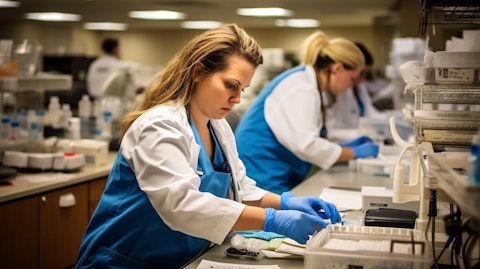DaVita Inc. (NYSE:DVA) Q3 2023 Earnings Call Transcript November 7, 2023
Operator: Good evening. My name is Jordan, and I will be your conference facilitator today. At this time, I would like to welcome everyone to DaVita’s Third Quarter 2023 Earnings Call. Today’s conference is being recorded. If you have any objections you may disconnect at this time. [Operator Instructions] Thank you. Mr. Eliason, you may begin your conference.
Nic Eliason: Thank you, and welcome to our third quarter conference call. We appreciate your continued interest in our company. I’m Nic Eliason, Group Vice President of Investor Relations and joining me today are Javier Rodriguez, our CEO; Joel Ackerman, our CFO; and Dr. Jeff Giullian, our Chief Medical Officer. Please note that during this call, we will make forward-looking statements within the meaning of the federal securities laws. All of these statements are subject to known and unknown risks and uncertainties that could cause the actual results to differ materially from those described in the forward-looking statements. For further details concerning these risks and uncertainties, please refer to our third quarter earnings press release and our SEC filings, including our most recent Annual Report on Form 10-K, all subsequent quarterly reports on Form 10-Q and other subsequent filings that we make with the SEC.
Our forward looking statements are based on information currently available to us. And we do not intend and undertake no duty to update these statements except as may be required by law. Additionally, we’d like to remind you that during this call, we will discuss some non-GAAP financial measures. A reconciliation of these non-GAAP measures to the most comparable GAAP financial measures is included in our earnings press release furnished to the SEC and available on our website. I will now turn the call over to Javier Rodriguez.
Javier Rodriguez: Thank you Nic, and thank you all for your interest in DaVita. We delivered another strong quarter. We began the year by making progress earlier than expected across many of our key operating priorities and that momentum has continued into the third quarter. We have balanced a strong focus on near-term operating discipline, while continuing to invest for future growth. At the same time, we’re creating a differentiated experience for our teammates, and of course, delivering the highest standard of care for our patients. Today, I will address our outperformance in the third quarter, share a perspective on the potential impact of GLP-1 drugs, provide an update on 2023 guidance, and then wrap up with some thoughts on next year.
Before we get into third quarter details, I’d like to start as I always do with a clinical highlight. This time, I will highlight our international business, which provides care for more than 40,000 patients across 11 countries. Each country is unique in terms of health status, local methods of practice, and regulation. Over the past 5 years, we have developed universal protocols to combine our kidney care experience with local practices within each country. Since launching this proprietary framework, we have seen consistent and meaningful improvement in clinical outcomes. We now outperform the clinical benchmarks of every international market in which we operate. And at the aggregate level, all cost patient mortality across our international countries has dropped by 20% since 2020.
These results energize the soul of our company, which is to extend life and improve the quality of life of our patients. Transitioning to our financial performance, we had a strong third quarter, delivering adjusted operating income of $525 million and adjusted earnings per share of $2.85. This was ahead of our expectations for the quarter. We continue to perform well across our key operating metrics, and also had additional benefit related to seasonality and timing. Now, let me go to the next level of detail and highlight three drivers including patient census, patient care costs, and integrated kidney care or IKC. First, our patient census has remained steady following the growth we saw in the first half of the year. And we expect to end the year with a census of 1,500 to 2,000 patients higher than the end of 2022.
Mortality continues to decline in 2023 in line with our expectations. Assuming these trends continue, we expect to return to positive volume growth in 2024 and beyond. Second, patient care costs continue to decrease during the third quarter. Outside of the seasonal items, the conversion to Mircera for anemia management was the key driver of the decrease. That said wage growth remains above historical trends and exceeds growth in revenue per treatment, but was below our expectations for the quarter. Our experience on labor is consistent with recent macro economic trends. The tight labor market and low unemployment has continued to put pressure on retention and training, offset by slight easing in the wage environment. And finally, our IKC business had a strong quarter and is tracking ahead of our forecast for the year.
We are improving patient health outcomes and reducing the total cost of care, which generates savings that is shared between DaVita and our partners. We also realized that revenue associated with these savings earlier in the year than anticipated. We continue to invest in growth while carefully managing our model of care costs and we remain on track with our multiyear plan to achieve breakeven by 2026. Transitioning to a topic of recent focus, there’s been a lot of discussion on GLP-1 drugs, including speculation on their potential impact to dialysis growth rate. We are excited by the evidence that these drugs could improve the health of many people worldwide. That said, despite the evolving body of evidence about the positive impact of these drugs will have on obesity, diabetes and cardiac disease, we continue to believe that the impact on dialysis volumes will be limited.
We believe this is true even if results from near-term clinical trials proved to be positive in regards to progression of chronic kidney disease or CKD. To explain our perspective, it is important to segment the population based on disease state. In the group that is upstream from CKD Stage 3, it is intuitive that lower obesity should lead to lower incidence of diabetes and hypertension, lower incidence of chronic kidney disease and ultimately fewer people on dialysis. This thesis is built on many uncertainties within a progressive disease, but the one area where we can have clarity is in regards to timing. In this population, the progression to end stage renal disease is typically 15 to 20 years or longer. Suffice to say, this scenario is beyond the horizon of our strategic plan.
Now, turning at late stage CKD population. We believe that there are four key factors. First, GLP-1 adoption rate in CKD population. Second, the impact on CKD progression. Third, the offset impact of cardiac mortality benefit, and finally, the impact on payer mix due to any changes in the average patient age. For the purpose of building a conservative forecast, we assume robust adoption and long-term adherence, supported in part by the possibility of strong uptake by those who may take GLP-1s for obesity, rather than for the CKD benefit. We also looked at a wide range of possible clinical impact from current and future clinical trials. Stimulating across these assumptions, the midpoint of our model reflects a neutral impact on 10-year dialysis growth rates with a small, but immaterial impact on payer mix.

We recognize this may not sound intuitive, which is why we must consider several misunderstood characteristics about kidney disease. If we look at the approximately 16 million people in the U.S today, with CKD Stage 3 and beyond, over the next 10 years, approximately 75% will pass away before reaching end stage kidney disease. This compares to less than 10% of those individuals who will ultimately progress to dialysis. Since major adverse cardiac events are the single largest cause of this mortality, the positive impact of reduced cardiac event has a much larger population to influence than the effect of timing from slower disease progression. To better quantify the downside case on dialysis growth, we also model the scenario in which efficacy is found across all kidney endpoints in each of the flow and select trials with zero offsetting cardiac mortality benefits.
This scenario, which should be clear is not something we expect reflects a 0.5% annual growth headwind over the same 10-year period based on our model. This would equate to approximately $25 million of operating income headwind per year. Let me wrap up by acknowledging the disconnect between our view and what we believe is the markets perspective. To be clear, the disconnect is not related to the popularity of GLP-1 or their numerous health benefit, but specific to the impact on kidney care. Because of this, we have pressure tested our analytics with external epidemiologists and consultants with extensive review available research and across a wide band of assumptions. We are focused not on the midpoint, but on the downside scenario on volume, and incorporated possible financial headwinds from lower commercial mix.
In the end, our conclusion, based on what we know today, is that strong adoption of these drugs will not prevent us from achieving our long-term operating income growth targets in the next 10 years. This is a complicated topic, and we’re happy to elaborate or answer any questions on our assumptions. Transitioning topics. Looking forward to our fourth quarter, we are revising our 2023 adjusted operating income guidance range of $1.565 billion to $1.675 billion to a new range of $1.65 billion to $1.725 billion. We are also updating our adjusted earnings per share range of $7 to $7.80 per share to a new range of $7.80 to $8.30 per share. It’s too early to give guidance for next year, but we expect 2024 to be a year of positive growth in volume and adjusted operating income.
Despite continued cost pressures and our ongoing commitment to invest in our teammates, we expect the midpoint of our 2024 adjusted operating income guidance will fall within our long-term target growth rate of 3% to 7%, driven by continued progress on our operating initiatives. We will provide more detail during our fourth quarter call. With that, I will now turn it over to Joel to discuss our financial performance and outlook in more detail.
Joel Ackerman: Thanks, Javier. I will walk through the strong performance in the quarter, provide some detail about how we are thinking about the fourth quarter and give an update on capital deployment. Starting with volume, Q3 was in line with our expectations. U.S dialysis treatments per day and census were approximately flat to the second quarter. For the first time since the pandemic began, we’ve now experienced three sequential quarters of year-over-year growth in admits. Trailing 12 months mortality rate continues to decline, we are now approaching pre-pandemic levels of mortality rate as we once again improved quarter-over-quarter. Revenue per treatment was up $3.60 versus Q2. This increase was the result of continued improvements in our revenue cycle performance as well as normal contracted rate increases and an uptick in private pay mix.
For the full year, we expect to be near the top end of the 2.5% to 3% year-over-year RPT range that we shared last quarter. Looking ahead to 2024, the Medicare PPS final rate for ESRD was released last week. Despite CMS acknowledging that the 2022 forecast error was larger than originally calculated, the net rate update finalized for 2024 was only 2.1%, which is still below what we believe is appropriate given continued forecasting errors, current inflation and other rising costs. That said, we continue to find ways to expand margin despite RPT increases below current inflation trends. Non-GAAP patient care cost per treatment was down $2.30 sequentially. As Javier mentioned, this was the result of a number of items including the conversion to Mircera for anemia management.
In IKC, quarter-over-quarter results improved by $50 million due to two factors. First, we recognized approximately $45 million more of shared savings revenue in the third quarter than in the second quarter. It is important to note that this is higher than our forecast, but the difference is primarily timing as we had anticipated this revenue in the fourth quarter. Second, we had $15 million of positive adjustments from reconciliations from our Special Needs Plans in the quarter. These revenue increases were offset by approximately $10 million of higher costs. Because of the concentration of the shared savings revenue in Q3, we are forecasting a decline in IKC operating results in Q4 compared to Q3. As we have said in the past, results in the IKC business are likely to be somewhat volatile from one quarter to the next.
So focusing on annual results remains the better way to understand our performance. Our IKC business continues to make progress and we now expect a full year 2023 IKC adjusted operating loss of approximately $110 million, which is slightly ahead of our prior 2023 guidance. Turning to Q4, our updated operating income guidance implies fourth quarter adjusted operating income of $380 million, a sequential decline of approximately $145 million. The vast majority of the delta is due to two factors, IKC and seasonality. In IKC, fourth quarter results will be lower due primarily to timing as previously noted. The fourth quarter will also have typical seasonality driven by several factors including higher mistreatment rates around the holidays, higher spend on health benefits for our teammates, increased G&A and other year-end costs in the fourth quarter.
The magnitude of this seasonality is higher than what we would normally see in the fourth quarter this year. We closed or consolidated 15 clinics in the third quarter, bringing our year-to-date number to 51. We will continue to evaluate our footprint in light of utilization trends. On taxes, we now expect our full year 2023 tax rate to be approximately 23% to 24% which is below our previous range for the year. The updated range is reflective of larger benefits recognized for stock-based compensation and forecasted tax credits. Transitioning to the balance sheet, our capital allocation strategy remains focused on capital efficient growth. As we have said in the past, we target maintaining a low leverage ratio of 3 to 3.5x EBITDA over the long-term, and had paused our share repurchase program 1-year ago as part of our goal to return to this range.
Accordingly, we did not repurchase any shares this past quarter, and we ended the quarter with a leverage ratio near the middle of our target range. As a result, and after considering our typical set of capital allocation principles, including our view of intrinsic value relative to current market price of our stock, we intend to resume purchasing shares this quarter. We expect to fund share repurchases using a combination of excess cash flow and capacity within our revolving credit facility. As a reminder, we upsized our revolver earlier this year to provide us with more liquidity and flexibility in our capital structure. We continue to manage our exposure to rising interest rates. Approximately half our debt is long-term notes with very attractive fixed rates, while the other half of our debt is floating rate, we have implemented interest rate caps to manage the majority of this exposure through the end of 2025.
That concludes my prepared remarks for today. Operator, please open the call for Q&A.
See also 20 Most Stolen Vehicles in the US in 2023 and 20 Easiest Dental Schools to Get Into Recently.
Q&A Session
Follow Davita Inc. (NYSE:DVA)
Follow Davita Inc. (NYSE:DVA)
Operator: Thank you. [Operator Instructions] Our first question comes from Pito Chickering with Deutsche Bank. Your line is open.
Pito Chickering: Hey, good afternoon guys and thanks for taking my questions. I guess a couple for me here. I guess on year-over-year patient care costs, you guys were some pretty big reductions sort of year-over-year and sequentially. You sort of talked about changes within looking to be managing. But can you just help us sort of think about sort of what were the drivers — bridge those drivers to us? And then why not talking about 2024, you’ve done a pretty amazing job this year controlling costs, I guess, do you still see the same opportunity going into next year?
Javier Rodriguez: Yes. Thanks for the question, Pito. So if you think about patient care costs, I think the right way to think about it is continued wage rate — wage rate pressure, which we are seeing. As you think about SWBs that is offset by the lower contract labor. Remember, last year, that was a big pain for us and we’ve got that under control relatively early in the year. So you’re probably seeing the better part of $100 million, maybe a little bit less than that. But of that order of magnitude, in savings year-over-year. In terms of other items, we’ve done a nice job here controlling our anemia costs. We’ve talked about that in terms of the reduction from the switch to Mircera. And then you have additional savings from us consolidating our footprint, as a result of lower patient volumes.
So those are the big items year-over-year. If you think about 2024, I think we anticipate continuing to see pressure on the wage rate, relative to a pre-COVID number. I don’t think we are ready to give guidance on where that will land, but it’s certainly not coming back to the pre-COVID level from what we see now. We would expect some continued savings, as the savings from both Mircera and our facility closings annualize. And then as you would expect, we will continue to look for other opportunities to bring the cost down to mitigate, what ultimately will be a higher wage rate pressure than we see in our RPT growth.
Pito Chickering: Okay. And then shifting sort of to the GLP-1s, we sort of tried to do the same thing a few weeks ago, sort of building out a 10-year model. There’s definitely a lot of moving parts here. Any chance you guys want to sort of share with us the model that you guys had just so we can play with the assumptions within those variables. And at the same time, can you just sort of talk to us about what you saw with HCL2 inhibitors, what impact did you guys see from CKD patients going to [indiscernible] disease from that drug and just as you think about the impact from GLP-1s?
Javier Rodriguez: Well, Pito, this is Javier. And I saw your note. So you’ve been swimming and all the complexity here. So since there’s different levels of familiarity and understanding on the call, and as you know, the variables have interplay with one another. I think it would be good to step back, get a common foundation, so that we can all take off from the same place. So to get that model, that you asked for, what I’m going to ask is, first, for our Chief Medical Officer, Dr. Gillian to provide a high-level overview of the Clinical. And then I’ll hand it over to Joe, and he can give us a bit of the financial impact, so we could give you a framework, and then we can talk about assumptions. Is that fair?
Pito Chickering: Sounds good.
Javier Rodriguez: All right. Dr. G.
Jeffrey Giullian: Yes. Perfect. Thanks, Pito. Let me just start by saying, I acknowledge the energy and society right now, all around these medications. And as Javier mentioned at the outset, I’m encouraged, I think we are all encouraged that these drugs can truly change the lives of many people, and we certainly endorse the use of therapies that benefit people living with heart disease and those living with kidney disease. When it comes to the GLP-1 agonist, they’ve been available since 2005. They’ve generated dozens of high-quality clinical studies. And what I found interesting is that really fewer than half of the studies that even looked at kidney disease, demonstrated any efficacy and delaying progression. So that’s about 40% of those studies showed no improvement.
40% showed some aspects of improvement and then about 20% had some mixed results. And then, of course, of those that demonstrated, that improvement or the impact, the greatest impact was on a subset of patients. And so that’s where we started with all of this. Now like you’re probably wondering, I think the two biggest questions I get are: a, what percent of people are ultimately or do we ultimately expect are going to be on these medications? And then b, what percent delay in progression of CKD is that going to lead to? So let me kind of walk you through our clinical thinking, and then I’ll hand it off to Joel to talk more about the financial impact. On that first question about 5% to 8% of patients right now with CKD are on these medications.
And the published discontinuation rates is high as 69%. And to be very conservative in our model, we’ve ultimately estimated that about 30% of CKD patients could someday take these medications, and we arrived at that number by triangulating from a number of different data points. We looked at uptake of other medications, including generic medications, which are known to slow kidney dysfunction. We looked at patient clinical eligibility. And specifically on that one, about 70% of CKD patients, who ultimately progress to dialysis, are either obese or have diabetes or both with the other 30% really not being eligible for these drugs. And so we were assuming about 40% of those that are eligible could potentially receive these medications in the future.
And then that would translate to at maximum, we believe, around 30% of the total CKD patient population, who would be on these medicines of those that ultimately progress to dialysis. So that’s the first part of the question. The second part of the question is how to estimate impact. And we did that by looking at things, that we know of, in terms of evaluating slowing disease progression. And that is if there is even a delay with these medicines. Right now, we are estimating a 25% delay in progression. And to arrive at that number, we looked at the impact in the subset of clinical trials that did demonstrate renal progression efficacy. And as I had mentioned, that’s about 40% of those studies. And then we picked the data points from those of the smaller subpopulations in those studies, where the medications demonstrated benefit.
And so in general, that appeared to be about 25%, and we use that 25% to really extrapolate for the broader CKD population. And again, this was to be conservative in our approach. And I’ll just sort of end by saying no therapy has really demonstrated the halt progression or reversal of kidney damage over time. And — so that goes to the second part of your question, which includes the SGLT2s. Right now about 8% of our ESRD population has been on an SGLT2 and that’s for a number of reasons, including the fact that about 65% of patients that get prescribed those medications ultimately discontinue them. So that impact, we believe we have considered already in our model, and I’ll let Joel share a little bit more on that.
Javier Rodriguez: Great. Thank you, Dr. Giullian. So I have had the benefit of weeks and weeks of being steeped in the clinical aspects of this with Dr. Giullian, other nephrologists, epidemiologists, both internal as well as external. So let me try and sum up what Dr. Giullian said and then I’ll talk about our modeling. I would say three things. First, our assumptions are not pulled out of the air. These GLP-1 drugs have been used for at least 7 or 8 years for the management of diabetes. So there are a number of robust studies, as Jeff said. So there is a data set off of which to build some assumptions. That said, there’s a lot of uncertainty still, and we wanted to be conservative. So we landed on two assumptions that are incorporated in our modeling.
First, that 30% of the CKD population will be on these drugs. It’s not going to happen overnight. It will play out over time. That’s one of the things that makes the modeling complex. So that’s assumption one, a 30% utilization rate or penetration rate among our population. Again, we think that is a conservative number. Second, a 25% efficacy rate. And what that means is for the patients, who take this drug, their progression in CKD will be slowed down by 25%. To put numbers on that, if you think of a typical CKD patient progressing from a later stage of CKD to ESRD over 10 years, that would convert that 10-year progression to 12.5 years. So those are the clinical inputs that we are using for our modeling. Now let me turn to how we modeled two different numbers.




